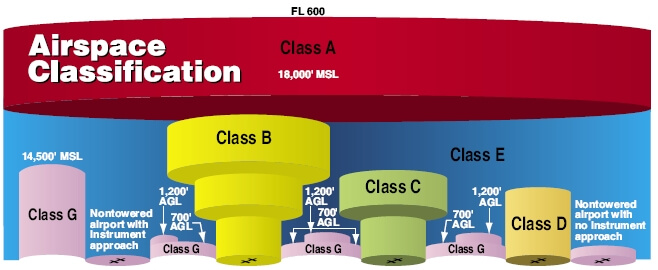Navigating the skies isn’t just about controlling the aircraft—it’s also about understanding where you’re flying. Airspace is divided into different classes to organize and manage traffic safely and efficiently. Each class has its own rules, weather minimums, and ATC requirements.
Here’s a quick breakdown of the main classes of airspace (A through G) in the United States, designed to help you fly smarter and safer.
✈️ Airspace Classes at a Glance
| Class | Altitude Range | Controlled? | ATC Clearance Required? | Weather Minimums (VFR) | Common Uses |
|---|---|---|---|---|---|
| A | FL180 (18,000′) to FL600 (60,000′) | Yes | Yes | IFR only | High-altitude en route traffic |
| B | Surface to ~10,000′ AGL (varies by airport) | Yes | Yes | 3 SM, clear of clouds | Major airports (e.g., LAX, Heathrow) |
| C | Surface to 4,000′ AGL (around towered airports) | Yes | Yes | 3 SM, 1,000′ above, 500′ below, 2,000′ horizontal | Medium-sized airports (e.g., San Jose, Munich) |
| D | Surface to 2,500′ AGL (around towered airports) | Yes | Yes | Same as Class C | Smaller towered airports |
| E | Starts at 700′ or 1,200′ AGL to Class A | Yes | No (for VFR) | Same as Class C/D | IFR/VFR traffic outside towered airspace |
| F | Varies by country | Can be both | Sometimes | Varies by local regulations | Advisory or restricted airspace (e.g., Canada, UK) |
| G | Surface to base of overlying Class E | No | No | 1 SM (day), 3 SM (night); clear of clouds | Uncontrolled rural airspace |
🌍 About Class F Airspace
Class F is not used in the United States, but it is recognized by ICAO and used in countries like Canada, UK, and others. It may be:
- Advisory Airspace: IFR and VFR allowed; ATC provides information but not control.
- Restricted Airspace: Entry requires permission (e.g., for military or sensitive operations).
Always check the local AIP (Aeronautical Information Publication) when flying internationally.
💡 Quick Tips:
- Class A is always IFR—no VFR flights allowed.
- Class B is the most restrictive for VFR; you need a clearance to enter.
- Class C and D both require two-way radio communication with ATC.
- Class E can exist almost anywhere above Class G, and is where most VFR and IFR traffic fly outside busy areas.
- Class G is the “wild west” of airspace—no ATC, but still subject to FAA regulations.
Understanding where you’re flying is just as important as how you’re flying. Keep this guide handy and fly smart!

